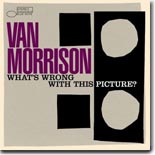|

Van Morrison
What's Wrong With This Picture
Blue Note

The inclusion of a featured review of a Van
Morrison CD on a blues-related site will not surprise anyone that has
followed the career of the Irish-born signer. Morrison typically packs
more feeling and emotion into his songs than most performers could ever
dream of being able to do.
In short, Van Morrison has soul.
On his latest, What's Wrong With This
Picture? (Blue Note), Van the Man chose to include a number of blues
numbers, mostly original compositions, amidst his usual eclectic mix of
jazz, soul and rock. His forays into the blues are mostly successful and
rewarding ventures.
The CD kicks off with the title cut, easing
the listener in with a a six-minute, laid-back number with an ethereal
quality to it and featuring tasteful guitar picking from Foggy Little (now
there's a great name!).
Morrison then turns it up with a jump blues
original, "Whinin' Boy Moan," with the first of the frequent hot B-3
accompaniment from Richard Dunn and a foot-tappin' sax solo from Martin
Winning and trumpet from Matt Holland. With this cut Morrison sends the
listener a strong signal that he's ready to give them the blues.
The mood changes on "Evening in June," a
jazzy, brassy Caribbean sound highlighting the contributions of Holland's
flugelhorn and Winnings' clarinet.
"Too Many Myths" jumps back into a blues vein,
but this tune presents more of a 'back porch' mood. Little checks in with
nice snaky guitar, while Gavin Povey does a good job on the blues piano.
One of the stronger numbers on What's Wrong
With This Picture?, and one which you will want to hear over and over,
is the bluesy "Meaning of Loneliness." Morrison doesn't get overly deep
with his vocals, yet still delivers an accurate feeling of despair.
Morrison shows that he's perfectly capable of
handling a late night blues on the original "Goldfish Bowl," the tale of a
musical artist struggling with being in the public spotlight. Could this
song perhaps be in part autobiographical, as Morrison has battled stage
fright throughout his career? Regardless, it's a powerful number, with
Dunn's B-3 work providing a framework for Morrison's vocals.
On one of the two covers on the album,
Morrison adds new life to the traditional blues/jazz number "St. James
Infirmary," making it even eerier and mysterious than other versions, with
Dunn's mournful keyboards adding to the mood. The New Orleans mood comes
from the dirge-like horn accompaniment.
"Fame" is another top-notch straight blues
number, a mid-tempo original with more hot guitar work from Little. It's
kind of a follow-up to "Goldfish Bowl," with Morrison chastising those
corrupted in the search for fame and notoriety.
Morrison has always incorporated elements of
classic soul into his repertoire; this time around the disc's closing
number, "Get On With The Show," features a big, brassy horn intro that
would not have been out of place on a Stax recording. It's also
reminiscent of material done by groups like the Drifters, reminding one of
past walks along the boardwalk.
The only cut that doesn't work is a cover of
Lightnin' Hopkins' "Stop Drinking," done in more of a rockabilly format.
The band certainly gives it their all, but Morrison sounds like he just a
little too far out of his territory.
What's Wrong With This Picture? is a
worthy addition to Morrison's vast recording legacy. It's one that you
should enjoy hearing many times.
--- Bill Mitchell
|


![]()